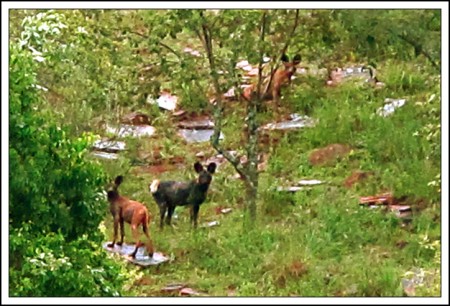We’ve fallen into a pleasant routine here in the Mara. We try to gather in the dining tent by 6:30 for a quick breakfast of fruit and coffee (Calvin would like us to be up by 5:30 but it’s just not going to happen). Early morning is the best time of day. The air is cool and fresh, the sky alive with chattering starlings and weavers and mourning doves. It is the cooing of mourning doves that, for me, is the soundtrack of Africa.
We might spend three or four hours looking for game, always with a specific species in mind, yet we are easily distracted. In search of a leopard in a tree we instead come across three or four Masai giraffe browsing on a flat topped acacia or cautiously sipping at a water hole, their ridiculous legs splayed out in all directions, like a dog on an ice-skating rink, which is when they’re most vulnerable to an attack by a lion. Do you know how easy it is to spend your morning just watching a giraffe drink?
And then there’s always the wild goose chase like the one we went on this morning. Yesterday Calvin heard a report that a pack of wild dogs was in the area. Very rare. Once common in the Serengeti and Masai Mara, they’ve been reduced to almost nothing as a result of disease and persecution by the Masai and other tribes because they are a threat to livestock. I’ve read that even 20 years ago there were probably 500,000 wild African dogs and now there may be less that 4,000 remaining.
Pound for pound African wild dogs may be the most efficient hunters in East Africa. Hunting in a pack, they pursue their victim relentlessly, handing off chase duties much the way cyclists do in a peloton until their prey is exhausted. Then 20 or 30 or more wild dogs come in for the kill, dragging smaller antelopes or even a zebra to the ground.
Anyway, Chris Mahoney, one of the guides at Cottars Camp, was told by the local Masai yesterday that there were some of these rare animals in the area so he spent most of the day looking for them, finally coming across 15 or 20 of them with pups in a den just before dusk. He snapped this photo of three of them with his cell phone just to show us. The quality of the pic isn’t very good but you get the idea.
The thing is, wild dogs don’t stick in any one place for very long. They have an incredible hunting range that can extend for hundreds of miles and tend to hang out at one place for maybe three weeks before moving on. Which is why Calvin was rather keen to take us out looking for them early this morning (they hunt mainly at dusk and dawn and tend to hide in their dens during the heat of the day). They’re extremely elusive however, particularly around man (as they should be) and we never could find them. Not that it really mattered. Just being out in the open grassland for the morning was reward enough.
Tags: Masai Mara
-
what the ?? can’t get up for a 5:30 start? you guys would never make good surfers. jeez, ya sleep when you’re dead. how often you gonna get the opportunity to see what you see at 5:30 in the bush of east africa, esp if the game guru is telling you that’s the best time? oh boy….
-
As Iunderstand it Hardy was always up at 04:00 for a quick jog and some early morning pics, and then came back to camp to wake up Mr Sleepy Lansing. True about the snoring, poor Malin…..
Comments are now closed.



3 comments